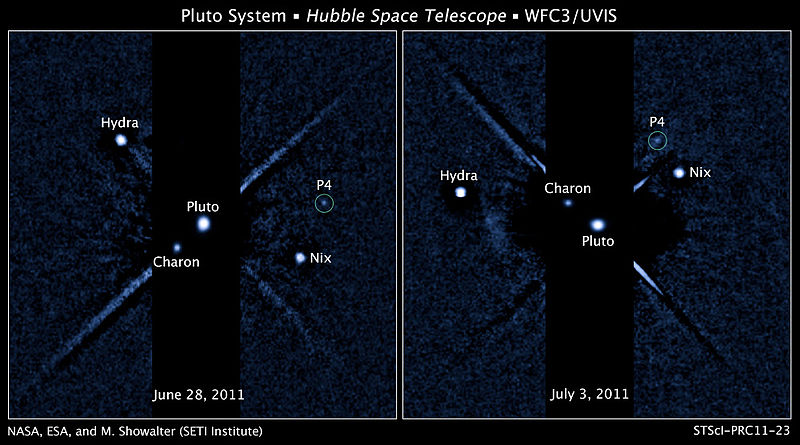Added 1 new A* page:The author of the webcomic Calamities of Nature has been doing a weekly science blog update, and as he seems actually to keep up regularly with goings on, I have a recent post of his to thank for pointing out that Hubble discovered a fourth moon of Pluto--or scientists using Hubble did, anyway. Currently known by clunky temporary designations--S/2011 P 1, or "P4"--it is a tiny moon with an estimated diameter of "8 to 21 miles (13 to 34 km)," which is a fair deal smaller than Pluto's two other small moons, Nix and Hydra (20 miles (32 km) and 70 miles (113 km) across, respectively), and way smaller than Pluto's largest moon, Charon, which is 648 miles (1,043 km) across (and not really all that much smaller than Pluto itself, which has a diameter of about 2,300 kilometers; in fact, Pluto/Charon qualifies as a binary system, since their mutual center of gravity is above the surface of Pluto--some astronomers, apparently, even call the pair a "double dwarf planet"; another interesting Pluto/Charon factoid is that they're both tidally locked to each other--the same part of the surface of each is always facing the other).
Here are a couple of Hubble's recent shots of the system, in which P4 could be seen:

image by NASA (source)
Hubble was actually being used to look for any rings that might exist around Pluto, and the long exposures it was taking for that allowed the tiny P4 to be visible in the resulting images.
Well! It isn't every day a new moon is discovered in our solar system; and this discovery adds a bit more spice to the New Horizons mission, which is expected to reach Pluto in 2015. Will even more moons be discovered?
Surprisingly, there is no real precise definition of what qualifies as a moon. Wikipedia says: "Every body with an identified orbit, some as small as a kilometer across, has been identified as a moon, though objects a tenth that size within Saturn's rings, which have not been directly observed, have been called moonlets." So currently the title "moon" is a bit arbitrary; I would hope, though, that if New Horizons finds, say, meter-sized rocks going around in the Pluto dwarf system, they don't call those "moons"; I mean, you've got to draw the line *somewhere*, right? The line has tended to shift around, though; Wikipedia also says
| As of July 2009, 336 bodies are formally classified as moons. They include 168 orbiting six of the eight planets, seven orbiting three of the three dwarf planets, 104 asteroid moons, and 58 satellites of Trans-Neptunian objects, some of which will likely turn out to be dwarf planets. Some 150 additional small bodies were observed within rings of Saturn, but they were not tracked long enough to establish orbits. Planets around other stars are likely to have natural satellites as well, although none have yet been observed. |
That's a lot of moons already, and with better observation of who knows how many scads of Trans-Neptunian and so on objects there are floating around way out in the far reaches of our solar system, well, some day we may really be up to our ears in moons if something isn't done!
|
